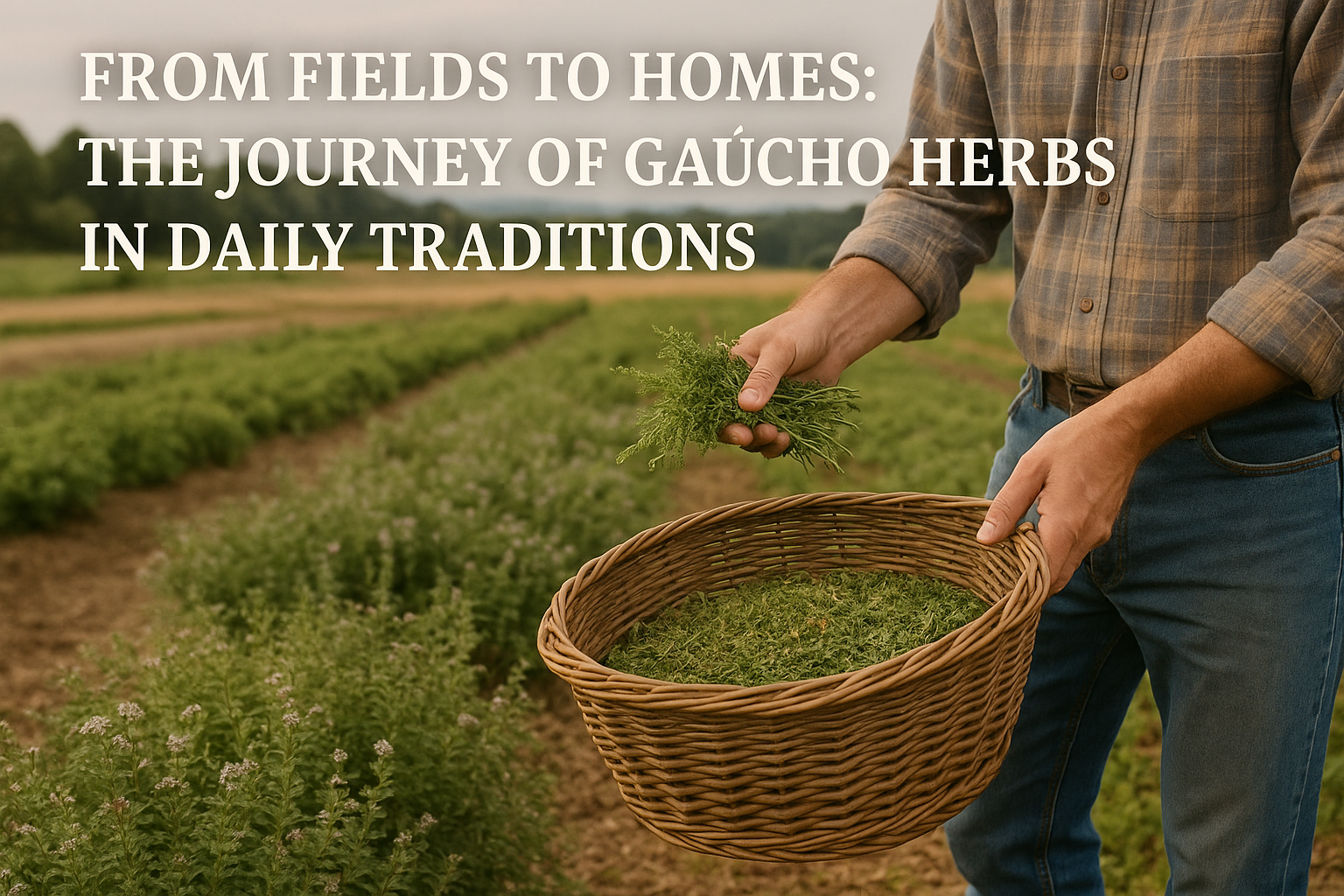The southern region of Brazil, known for its sweeping pampas and rich cultural identity, has a strong connection to herbs.
Gaúcho traditions, shaped by centuries of rural life, gave birth to practices that turn these plants into everyday allies.
From the fields where they grow wild to the homes where they are preserved, Gaúcho herbs continue to play a vital role in well-being, rituals, and community life.
Understanding this journey helps us appreciate not only the plants themselves but also the cultural wisdom behind them. Each herb carries stories of resilience, resourcefulness, and connection to the land.
The Roots of Gaúcho Herbal Traditions
The Gaúchos, historically cattle herders and rural workers of Southern Brazil, Uruguay, and Argentina, lived in close harmony with nature.
With vast open fields as their environment, they relied heavily on what the land offered. Herbs were more than ingredients; they were symbols of survival.
Long before modern medicine and manufactured fragrances reached rural households, herbs were gathered to address ailments, purify environments, and add meaning to rituals. Their availability and adaptability made them central to daily life.
Gathering Herbs in the Pampas
Collecting herbs was not a casual task. Gaúcho families knew the exact seasons when specific plants reached their peak potency.
For example, marcela, one of the most iconic regional herbs, was often harvested during Easter, a tradition passed down through generations.
The act of gathering involved both practical knowledge and a sense of respect for nature. Families would wake early, sometimes before sunrise, to ensure herbs were collected at the right time of day. Morning dew was believed to enhance the strength of the plants.
Preserving the Harvest
After harvesting, drying herbs was crucial. The pampas climate, with its dry winds and sunny days, naturally aided the preservation process.
Families hung bunches upside down in shaded areas, allowing the leaves and flowers to retain their fragrance and properties.
Once dried, herbs were stored in cloth bags or clay containers to protect them from moisture. This ensured that families had access to their herbal remedies throughout the year, especially during winter when illnesses were more common.
Herbs as Cultural Symbols
For Gaúchos, herbs carried meaning beyond their practical use. They became part of cultural identity. Marcela was associated with Easter blessings, rosemary with protection and purification, and boldinho with digestive health. Each plant had both a physical and symbolic function.
These associations turned herbs into carriers of tradition. Even today, many households in Southern Brazil keep small bundles of rosemary at the entrance to symbolize good energy and ward off negativity.
Everyday Domestic Uses
Inside Gaúcho homes, herbs were used in countless ways. They flavored infusions, cleansed living spaces, and freshened linens. Some were burned to release protective smoke, while others were added to cooking pots for their aromatic qualities.
Herbal teas became a daily ritual. After long days in the fields, families would gather and drink infusions that soothed the body and encouraged conversation. This practice reinforced both health and social connection.
The Link to Mate Culture
No discussion of Gaúcho traditions is complete without mentioning mate, the iconic drink prepared with yerba mate leaves. While mate is not an herb in the narrow sense, many Gaúchos enhanced the infusion with regional herbs.
Adding marcela or mint to mate created variations in flavor and gave the drink additional properties. This blending practice reinforced the idea that herbs were flexible companions to daily routines.
Healing Rituals in Homes
Gaúcho herbalism was deeply tied to folk healing. Families passed down recipes for teas, baths, and poultices designed to relieve common ailments. A child with a stomach ache might be given boldinho tea, while rosemary baths were believed to renew energy and cleanse the spirit.
These remedies were not seen as replacements for medical care but rather as part of a holistic approach to well-being. They blended practicality, symbolism, and family tradition.
The Role of Women in Herbal Knowledge
Women played a central role in maintaining herbal traditions. Mothers and grandmothers taught younger generations how to identify, gather, and prepare herbs. They were keepers of recipes and guardians of seasonal practices.
This transmission of knowledge kept herbal traditions alive even as modernity began to change rural life. In many households today, grandmothers remain the authority on which herbs to use and when.
Herbs in Gaúcho Rituals and Celebrations
Beyond everyday use, herbs played roles in special occasions. Marcela collected at Easter was blessed in churches and later kept at home as a symbol of protection. Festive gatherings often included herbal infusions served alongside traditional foods.
Herbs also marked life transitions. Some were used in birth rituals, others in marriage ceremonies, and even in practices surrounding death. This spiritual dimension gave herbs a place in both public and private life.
The Journey into Urban Homes
As cities in Southern Brazil grew, Gaúcho traditions did not disappear. Many urban families carried herbal practices into their homes. Today, it is common to find rosemary plants on balconies, marcela sold in markets, and herbal teas enjoyed in apartments.
Urban living may limit access to wild herbs, but it has also encouraged innovation. People grow herbs in pots, buy dried versions at local fairs, and continue to value their presence in daily routines.
Connection to Modern Well-Being Trends
Interestingly, Gaúcho herbal traditions now align with global trends. The modern wellness movement values natural remedies, aromatherapy, and eco-friendly practices. What Gaúcho families have done for centuries now resonates with a broader audience.
This has created opportunities for small producers to sell herbal products, from teas to artisanal soaps, inspired by traditional practices. The market demand reflects both cultural preservation and economic potential.
Challenges to Preservation
Despite their cultural importance, Gaúcho herbal traditions face challenges. Industrialization, agricultural expansion, and environmental pressures have reduced the availability of some native herbs. Younger generations, more connected to technology, sometimes drift away from ancestral practices.
Preservation efforts are essential. Educational programs, local markets, and cultural projects help maintain interest in herbs and ensure that knowledge continues to be passed down.
Sustainability and Responsible Harvesting
A key element in the journey of Gaúcho herbs is sustainability. Overharvesting can threaten native plants, and responsible practices are needed to protect them. Communities are increasingly aware of balancing cultural use with environmental care.
By harvesting only during specific seasons, avoiding overcollection, and supporting local growers, Gaúcho families contribute to the preservation of biodiversity while keeping traditions alive.
Gaúcho Herbs as Fragrance Sources
Herbs are not limited to teas and remedies. Their strong scents make them natural alternatives to artificial air fresheners. Rosemary sprigs are often placed in closets, marcela flowers are used to scent linens, and herbal bundles are hung in kitchens for freshness.
This practice highlights the versatility of herbs, blending practicality with sensory pleasure. Homes infused with herbal aromas carry both comfort and cultural identity.
Education and Revival Among Youth
Recently, schools and cultural associations have embraced Gaúcho herbs as teaching tools. Children learn to identify plants, understand their uses, and respect traditional practices. This not only preserves knowledge but also builds appreciation for nature.
Workshops and festivals celebrating herbs are becoming more common, allowing younger generations to reconnect with their roots. These efforts give hope that traditions will continue to thrive.
From Local Wisdom to Global Inspiration
The journey of Gaúcho herbs, from the pampas fields to modern homes, carries lessons for the world. They represent a model of living in balance with nature, valuing cultural roots, and using resources responsibly.
What began as necessity has transformed into a cultural treasure. As Gaúcho herbs inspire wellness practices far beyond Southern Brazil, they remind us of the power of local traditions to shape global perspectives.
Final Thoughts
Gaúcho herbs are more than plants; they are stories, practices, and cultural bonds. Their journey from fields to homes illustrates how traditions adapt while retaining their essence.
Whether in a rural community or a modern apartment, these herbs continue to nurture both body and spirit.
By preserving and celebrating them, we honor the resilience of the Gaúcho people and the wisdom of nature itself.

Marcela Cardozo is passionate about Southern Brazilian traditions and the cultural stories carried through natural scents. She blends knowledge of native herbs, essential oils, and regional rituals to create practical and inspiring content. Her writing connects ancestral wisdom with modern living, offering readers simple ways to bring authenticity, well-being, and meaning into their everyday lives.
